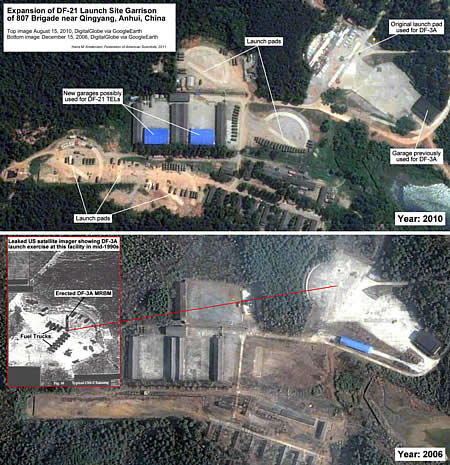New Nuclear Notebook: Indian Nuclear Forces, 2012
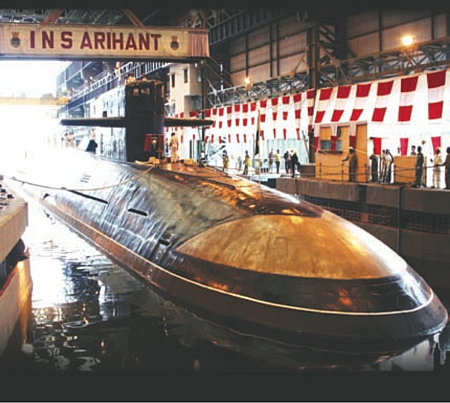 |
| The Indian government says its first nuclear ballistic missile submarine – the Arihant – will be “inducted” in mid-2013, a term normally meaning delivered to the armed forces. Several boats are thought to be under construction. Image: Government of India |
.
By Hans M. Kristensen and Robert S. Norris
Our latest Nuclear Notebook has been published by the Bulletin of the Atomic Scientists. We estimate that India currently has 80-100 nuclear warheads for its emerging Triad of air-, land-, and sea-based nuclear-capable delivery vehicles.
The latest test launch of a nuclear-capable ballistic missile occurred yesterday when an Agni I missile was launched by the Strategic Forces Command from a road-mobile launcher at the missile test launch center on Wheeler Island on India’s east coast in what the Indian government described as a “training exercise to ensure preparedness.”
 |
| India’s east coast missile test launch center has been expanded with a second launch pad since 2003. Click image for larger version. |
This publication was made possible by a grant from Carnegie Corporation of New York and Ploughshares Fund. The statements made and views expressed are solely the responsibility of the author.
Event: Conference on Using Satellite Imagery to Monitor Nuclear Forces and Proliferators
.
By Hans M. Kristensen
Earlier today we convened an exciting conference on use of commercials satellite imagery and Geographic Information Systems (GIS) to monitor nuclear forces and proliferators around the world. I was fortunate to have two brilliant users of this technology with me on the panel:
- Tamara Patton, a Graduate Research Assistant at the James Martin Center for Nonproliferation Studies, who described her pioneering work to use freeware to creating 3D images of uranium enrichment facilities and plutonium production reactors in Pakistan and North Korea. Her briefing is available here.
- Matthew McKinzie, a Senior Scientists with the Natural Resources Defense Council’s Nuclear Program and Lands and Wildlife Program, who has spearheaded non-governmental use of GIS technology since commercial satellite imagery first became widely available. His presentation is available here.
- My presentation focused on using satellite imagery and Freedom of Information Act requests to monitor Chinese and Russian nuclear force developments, an effort that is becoming more important as the United States is decreasing its release of information about those countries. My briefing slides are here.
In all of the work profiled by these presentations, the analysts relied on the unique Google Earth and the generous contribution of high-resolution satellite imagery by DigitalGlobe and GeoEye.
This publication was made possible by a grant from Carnegie Corporation of New York and Ploughshares Fund. The statements made and views expressed are solely the responsibility of the author.
Sanctions and Nonproliferation in North Korea and Iran
The nuclear programs of North Korea and Iran have been, for many years, two of the most pressing and intractable security challenges facing the United States and the international community. While frequently lumped together as “rogue states,” the two countries have vastly different social, economic, and political systems, and the history and status of their nuclear and long-range missile programs differ in several critical aspects.
The international responses to Iranian and North Korean proliferation bear many similarities, particularly in the use of economic sanctions as a central tool of policy. Daniel Wertz, Program Officer at the National Committee on North Korea, and Dr. Ali Vaez, former Director of the Iran Project at the Federation of American Scientists, offer a comparative analysis of U.S. policy toward Iran and North Korea in a FAS issue.
Second Batch of New START Data Released

By Hans M. Kristensen
The U.S. State Department today released the full (unclassified) aggregate data for U.S. strategic nuclear forces as counted under the New START treaty. The data shows only very modest reductions of deployed strategic nuclear weapons over the past six months.
The full U.S. aggregate data follows the joint and much more limited overall U.S. and Russian aggregate numbers released in March 2012. Under the previous START treaty, the United States used to make Russian data available, but accepted Russia’s demand during the New START negotiations to no longer release their data.
The joint aggregate data and the full U.S. aggregate data are released at different times and not all information is made reality available on the Internet. Therefore, a full compilation of the data is made available here.
Overall U.S. Posture
The New START data attributes 1,737 warheads to 812 deployed ICBMs, SLBMs, and heavy bombers as of March 1, 2012. This is a reduction of 53 deployed warheads and 10 deployed delivery vehicles compared with the previous data set from September 2011.
A large number of non-deployed missiles and launchers that could be deployed are not attributed warheads.
The data shows that the United States will have to eliminate 289 launchers over the next six years to be in compliance with the treaty limit of 700 deployed and non-deployed launchers by 2018. Fifty-six of these will come from reducing the number of launch tubes per SSBN from 24 to 20, roughly 80 from stripping B-52Gs and nearly half of the B-52Hs of their nuclear capability, possibly retiring 50 ICBMs, and destroying about 100 old ICBM silos.

The released data does not contain a breakdown of how the 1,737 deployed warheads are distributed across the three legs of the Triad. But because the bomber number is now disclosed and each bomber counts as one warhead, and because between 450 and 500 warheads remain on the ICBMs, it appears that the deployed SLBMs carried 1,112 to 1,165 warheads, or about two-thirds of the total number of warheads counted by New START.
Just to remind readers: the New START numbers do not represent the total number of nuclear weapons in the U.S. arsenal – only about a third. The total military stockpile is just under 5,000 warheads, with several thousand additional retired (but still intact) warheads awaiting dismantlement. For an overview, see this article.
Ballistic Missile Submarines
The New START data shows that the United States as of March 1, 2012, had 241 Trident II SLBMs onboard its SSBN fleet. That is a reduction of eight SLBMs compared with the New START data from September 2011, but it doesn’t reflect an actual reduction in missiles on deployable submarines but a fluctuation in the number of missiles onboard SSBNs during loadout. Each SSBN has 24 missile tubes for a maximum loadout of 288 missiles, but at the time of the New START count two SSBNs were empty and two only partially loaded. With an estimated 1,140 warheads on the SLBMs, that translates to an average of 4-5 warheads per missile.
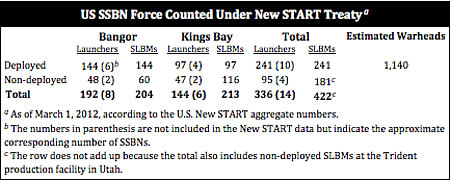
It is widely assumed that 12 out of 14 SSBNs normally are deployed, but two sets of aggregate New START data both indicate that the force ready for deployment at any given time may be closer to 10. This ratio can fluctuate significantly and in average 64 percent (8-9) of the SSBNs are at sea with roughly 920 warheads. Up to five of those subs are on alert with 120 missiles carrying an estimated 540 warheads – enough to obliterate every major city on the face of the earth.
Of the eight SSBNs based at Bangor (Kitsap) Submarine Base in Washington, the New START data indicates that two were out of commission on March 11, 2012: one had empty missile tubes – possibly because it was in dry dock – and another was only partially loaded – possibly because it was in the middle of a missile exchange when the count occurred. This means that six SSBNs at the base were loaded with Trident II D5 missiles carrying some 650 warheads at the time of the New START count.
For the six SSBNs based at Kings Bay Submarine Base in Georgia, the New START data shows that 97 missiles were deployed on March 1, 2012. That number is enough to load four SSBNs, with a fifth boat partially loaded. The 96 Trident II SLBMs on four SSBNs carried an estimated 430 warheads.
The New START data indicates that the U.S. Navy has not yet begun to reduce the number of missile tubes on each SSBN. The number will be reduced from 24 to 20 before the New START enters into effect in 2018.
Intercontinental Ballistic Missiles
The New START data shows that the United States deployed 449 Minuteman III ICBMs as of March 1, 2012. That is one more than on September 1, 2011. Most were at the three launch bases, but a significant number were in storage at maintenance and storage facilities in Utah. That included 58 MX Peacekeeper ICBMs retired in 2003-2005 but which have not been destroyed.

The New START data does not show how many warheads were loaded on the 449 deployed ICBMs, but the number is thought to be nearly 500. The 2010 NPR decided to “de-MIRV” the ICBM force, an unfortunately choice of words because the force will be downloaded to one warhead per missile, but retain the capability to re-MIRV if necessary. Downloading might have begun, but the status is unclear.
Heavy Bombers
The New START data shows that the U.S. Air Force possessed 147 B-2 and B-52 bombers as of March 1, 2012. Of these, 122 were counted as deployed, a reduction of three compared with September 2011.

Unfortunately the bomber data is misleading because it counts 36 retired B-52G bombers stored at Davis Monthan AFB in Arizona as “deployed” at Minot AFB in North Dakota. The miscount is the result of a counting rule in the treaty, which says that bombers can only be deployed at certain bases. As a result, the 36 retired B-52Gs are listed in the treaty as deployed at Minot AFB – even though there are no B-52Gs at that base. According to Air Force Global Strike Command, “There are no B-52Gs at Minot AFB, N.D…In accordance with accounting requirements, we have them assigned to Minot and as visiting David Monthan.” The actual number of heavy bombers should more accurately be listed as 86 B-2A and B-52H, with another 61 non-deployed (including the 36 at Davis Monthan AFB.
All of these bombers carry equipment that makes them accountable under New START, but only a portion of them are actually involved in the nuclear mission. Of the 20 B-2s and 91 B-52s, 18 and 76, respectively, are nuclear-capable, although only about 60 of those are thought to be nuclear tasked at any given time. None of the aircraft are loaded with nuclear weapons under normal circumstances but are attributed a fake count under New START of only one nuclear weapon per aircraft even though each B-2 and B-52s can carry up to 16 and 20 nuclear weapons, respectively. Roughly 1,000 nuclear bombs and cruise missiles are in storage for use by these bombers. Stripping excess B-52Hs and the remaining B-52Gs of their nuclear equipment will be necessary to get down to 60 counted nuclear bombers by 2018.
Conclusions and Recommendations
The New START data released by the State Department continues the decision made last year to release the full U.S. unclassified aggregate numbers, an important policy that benefits nuclear transparency and counters misunderstandings and rumors. In parallel with the data comes a busy treaty implementation effort and inspection schedule that reassures the United States and Russia that each side is abiding by the terms of the treaty. Now we need Russia to follow the U.S. example and also release its full unclassified data under New START.
The latest data set shows that the U.S. reduction of its deployed strategic nuclear warheads over the past six months has been modest: 53 warheads. The reduction is so modest that it might not reflect a cut as much as a fluctuation in the number of deployed weapons at any given time due to maintenance of delivery systems. While there have been some reductions of non-deployed and retired weapon systems, there is no indication from the New START data that the United States has yet begun to reduce its deployed strategic nuclear weapons.
Those reductions are scheduled to come, however, over the next five years as the New START treaty limits of 1,550 deployed strategic warheads and 700 deployed strategic delivery vehicles are to be met in February 2018. Despite the high cost of maintaining unnecessary weapon systems, 18 months after the New START treaty entered into force the Pentagon does not seem to be in a hurry to meet the treaty limits.
Download the full New START data here.
This publication was made possible by a grant from Carnegie Corporation of New York and Ploughshares Fund. The statements made and views expressed are solely the responsibility of the author.
NATO’s Nuclear Groundhog Day?
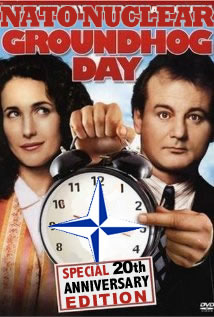 |
| At the Chicago Summit NATO will once again reaffirm nuclear status quo in Europe |
.
By Hans M. Kristensen
Does NATO have a hard time waking up from its nuclear past? It would seem so.
Similar to the movie Groundhog Day where a reporter played by Bill Murray wakes up to relive the same day over and over again, the NATO alliance is about to reaffirm – once again – nuclear status quo in Europe.
The reaffirmation will come on 20-21 May when 28 countries participating in the NATO Summit in Chicago are expected to approve a study that concludes that the alliance’s existing nuclear force posture “currently meets the criteria for an effective deterrence and defense posture.” [Update May 20, 2011: Turns out I was right. Here is the official document.]
In other words, NATO will not order a reduction of its nuclear arsenal but reaffirm a deployment of nearly 200 U.S. non-strategic nuclear bombs in Europe that were left behind by arms reductions two decades ago.
Visions Apart?
Although no one expected NATO to simply disarm, the reaffirmation of the current nuclear posture nonetheless falls far short of the visionary and bold initiatives that U.S. and Russian presidents took twenty year ago when they ordered sweeping reductions – and eliminations – of entire classes of non-strategic nuclear weapons deployed in Europe and around the world at the time.
President George W. Bush followed up by unilaterally reducing the remaining U.S. inventory in Europe by more than 50 percent, and president Barack Obama reinvigorated arms control and disarmament aspirations around the world when he declared in Prague in 2009 that he would reduce the role of nuclear weapons to put and end to Cold War thinking. He started by ordering the unilateral retirement of the Tomahawk sea-launched land attack cruise missile – completing the elimination of all U.S. non-strategic nuclear weapons from the navy, whose warships just two decades ago brought non-strategic nuclear weapons to all corners of the world.
Since then, current and former officials have been busy attaching preconditions to further reductions of non-strategic nuclear weapons. The venue for these efforts was NATO’s new Strategic Concept adopted in November 2010, which broke with two decades of unilateral reductions and decided that any further reductions of NATO forces must take into account the disparity with Russia’s larger inventory of non-strategic nuclear weapons. Why NATO suddenly needs to care so much about Russia’s aging and declining inventory of non-strategic nuclear weapons makes little sense.
Yet the Strategic Concept also promised that NATO would “seek to create the conditions for further reductions in the future” and, ultimately, “create the conditions of a world without nuclear weapons….”
Creating Conditions
So how will NATO create the conditions for further reductions and a world without nuclear weapons? The seven-page Deterrence and Defense Posture Review (DDPR) report to be released in Chicago (yes, the document will be made public) repeats this promise, but the short answer is: not by reducing forces but by studying it some more.
To that end, according to official sources, the DDPR will ask the North Atlantic Council (NAC) to task its committees to “develop concepts for how to ensure the broadest possible participation of Allies concerned [note: the DDPR identifies the “Allies concerned” as the members of the Nuclear Planning Group (NPG) – which is everyone except France] in their nuclear sharing arrangements, including in case NATO were to decide to reduce its reliance on non-strategic nuclear weapons based in Europe.” (Emphasis added).
So there appears to be some intent to reduce reliance on non-strategic nuclear weapons and adjust NPG procedures accordingly. But the DDPR also echoes the Strategic Concept formally making further reductions conditioned on Russian reductions:
“NATO is prepared to consider further reducing its requirement for non-strategic nuclear weapons assigned to the Alliance in the context of reciprocal steps by Russia, taking into account the greater Russian stockpiles of non-strategic nuclear weapons stationed in the Euro-Atlantic Area.” (Emphasis added).
Creating Obstacles
But one of the problems with using words such as “disparity” and “reciprocity” is that it is unclear what they mean and NATO has yet to explain it. For example, how much disparity is acceptable? No one expects NATO to seek parity in non-strategic nuclear weapons with Russia, so at what level does continued disparity become acceptable?
And what kinds of forces are counted when NATO talks disparity? Russia’s estimated inventory of air-delivery weapons is only a little greater than that of the United States (730 versus 500), so disparity is not significant in that weapons category. And while the Russian air-delivered weapons are stored separate from their bases, nearly 200 U.S. bombs in Europe are stored at the bases, inside aircraft shelters, a few feet below the wings of operational aircraft.
Likewise, most of Russia’s non-strategic nuclear weapons are in categories where NATO and the United States have none because they no longer needed them: naval weapons, air-defense weapons, and short-range ballistic missiles. No one expects NATO to argue that it needs such non-strategic nuclear weapons as well or that Russia must eliminate what it has in those categories. So does NATO’s concern over “disparity” not include those categories or does it?
The asymmetric composition of the non-strategic nuclear arsenals is one reason why it seems unclear (at best) why NATO would be able to “trade” an offer to reduce or withdraw U.S. nuclear weapons from Europe for Russian reductions in its non-strategic nuclear weapons. Most of Russia’s non-strategic nuclear weapons don’t exist because of U.S. nuclear bombs in Europe but to compensate for what Russia sees as NATO’s conventional superiority. So unless NATO reduces its conventional anti-submarine warfare capability, why would it expect Russia to agree to reduce or eliminate its non-strategic nuclear anti-submarine weapons?
It is simple questions like these that indicate that NATO hasn’t thought through what it means when it says that further reductions must take disparity and reciprocity with Russia into account. The DDPR to some extent acknowledges this by ordering NAC to task its committees to “develop ideas for what NATO would expect to see in the way of reciprocal Russian actions to allow for significant reductions in the forward-based non-strategic nuclear weapons assigned to NATO.” One would image that NATO had identified what it wanted from Russia before it started using “disparity” and “reciprocity” as conditions for additional reductions.
Looking Ahead
Despite the reaffirmation of nuclear status quo and other weaknesses in the DDPR, it seems that a process has been started. The Strategic Concept cleaned out most of the language that in the previous version explicitly identified the importance of U.S. non-strategic nuclear weapons in Europe, and the DDPR now tasks the NAC to figure out what it would look like if NATO reduced reliance on the weapons.
But while the NATO bureaucrats cautiously consider the next round of opportunities and definitions, modernization of the nuclear posture with the more accurate B61-12 bomb and stealthy F-35 aircraft is moving ahead to improve the military capabilities of NATO’s nuclear arsenal. This undercuts the pledge to create the conditions for further reductions and a world free of nuclear weapons.
To avoid that Chicago will be seen as a nuclear arms control disappointment and NATO as a military dinosaur incapable of shedding its Cold War non-strategic nuclear armor, it is essential that NATO announces new initiatives on limiting and eliminating non-strategic nuclear weapons quickly after Chicago.
The bureaucrats cannot deliver this; it requires presidential leadership. And that’s what’s missing in Chicago: the boldness that characterized earlier unilateral initiatives. The DDPR is ironically a more cautious document produced under far less threatening circumstances. Bold reductions have been reduced to a promise to develop confidence-building and transparency measures to increase mutual understanding of NATO and Russian non-strategic weapons in Europe. That’s nice and needed, but it doesn’t make the cut.
Rather than spending yet another decade thinking about how to adjust the role of nuclear weapon in Europe, NATO needs to move quickly on a next round of non-strategic nuclear arms reductions. Instead of getting lost in “disparity” and “reciprocity,” NATO should set the pace and announce its decision to withdraw the remaining U.S. nuclear weapons from Europe and call on Russia to follow suit with its own initiatives. Doing so would create room to maneuver for moderates in Moscow and deny hardliners (in the Kremlin as well as in Brussels) the excuse to stall the process of reducing non-strategic nuclear weapons. Otherwise 2022 will be NATO Nuclear Groundhog Day all over again.
Additional Information: Non-Strategic Nuclear Weapons report, May 2012 | NATO DDPR 2012
This publication was made possible by a grant from Carnegie Corporation of New York and Ploughshares Fund. The statements made and views expressed are solely the responsibility of the author.
B61 Nuclear Bomb Costs Escalating
 |
| The expected cost of the B61 Life-Extension Program has increased by 50 percent to $6 billion |
.
By Hans M. Kristensen
The expected cost of the B61 Life-Extension Program (LEP) has increased by 50 percent to $6 billion dollars, according to U.S. government sources.
Only one year ago, the National Nuclear Security Administration (NNSA) estimated in its Stockpile Stewardship and Management Program report to Congress that the cost of the program would be approximately $4 billion.
The escalating cost of the program – and concern that NNSA does not have an effective plan for managing it – has caused Congress to cap spending on the B61 LEP by 60 percent in 2012 and 100 percent in 2013. The Pentagon’s Cost Assessment and Program Evaluation (CAPE) office is currently evaluating NNSA’s cost estimate and is expected to release its assessment in July. After that, NNSA is expected to release a validated cost, schedule and scope estimate for the B61 LEP, a precondition for Congress releasing the program funds for Phase 6.3 of the program.
Ambitious Program
Beyond mismanagement, the 50 percent increase is due to the ambitious modifications that NNSA, the nuclear laboratories, and the Pentagon say are needed to extend the life of the bomb.
That includes new use-control and safety features to increase the surety of what is already the most safe warhead design in the stockpile. Several warhead design options were proposed, ranging from a simple life-extension with the current features to a significantly altered design with new optical wiring and multi-point safety. The Nuclear Weapons Council in December chose the second-most ambitious design without optical wiring and multi-point safety.
Expectation for the ambitious B61-12 program has already spawned a hiring frenzy at Sandia National Laboratory for a program that dwarfs the W76 LEP, the ongoing production of one of the navy’s Trident missile warheads. “It is the largest effort in more than 30 years, the largest, probably, since the original development of the B61-3,4,” according to the head of the B61 LEP at Sandia.
Program Justification
The Pentagon is promoting the consolidation of four B61 versions into the B61-12 as an effort to increase efficiency and lowering costs. But we have yet to see the budget justification for that and it is not clear how much of the savings will come from consolidation or from simply reducing the overall number of B61s in the stockpile. Already the consolidation part is turning out to be much more expensive than we were led to believe.
The B61 LEP was catapulted forward by the April 2010 Nuclear Posture Review, which committed – before a validated cost, schedule and scope estimate had been developed – the United States to conduct a “full scope” B61 LEP. That commitment came as part of a “deal” that promised significant investments in nuclear weapons modernization in return for Congressional approval of the New START treaty.
The Mission
The administration says that the B61 LEP is needed to provide nuclear extended deterrence to NATO allies and to continue a gravity bomb capability on the B-2 stealth bomber. According to the U.S. Air Force, the B61-12 is “critical” to “deterrence of adversaries in a regional context, and support of our extended deterrence commitments.”
But privately, U.S. Air Force officials do not see a need to continue the deployment in Europe, where the United States currently deploys nearly 200 B61-3/4 bombs in 87 aircraft shelters at six bases in five countries. And although the NATO Summit later this month is expected to endorse – for now – continuation of the current nuclear posture in Europe, none of the European allies appear to be willing to pay for continuing the mission.
Extended deterrence can be provided with other means and the B61-12 is not the only U.S. air-delivered nuclear weapon system. Indeed, the U.S. Air Force currently has seven different nuclear weapons for delivery by five different delivery platforms. After completion of the B61-12 program, the Air Force will still have four different nuclear weapons for delivery by five different aircraft.
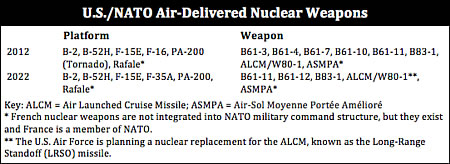 |
| The U.S. Air Force has six different nuclear weapons for delivery by five different aircraft. After the B61 LEP it will still have four weapons for five aircraft. |
.
Why so many different ways of delivering a nuclear weapon from the sky is needed for deterrence is anyone’s guess. The nuclear redundancy in the bomber leg is significantly greater than for ICBMs and SLBMs and appears to be the result of a combination of a left-over Cold War mission in Europe and requirements developed by warfighters to hold a variety of targets at risk in a variety of different ways.
Conclusions
After having spent hundreds of millions of dollars between 2006 and 2010 on extending the service life of the secondary of the B61-7 (and adding new spin-rocket motors to improve performance), NNSA and DOD are now planning to scrap the weapon and replace it with the $6 billion B61-12.
Although the cost estimate of the B61 LEP has increased by 50 percent over the past year, the $6 billion price tag is only part of the cost. The new guided tail kit the Air Force is developing to increase the accuracy of the B61-12 is expected to cost about $800 million. And the cost of making the F-35 Joint Strike Fighter capable of delivering the bomb is estimated to add another $340 million.
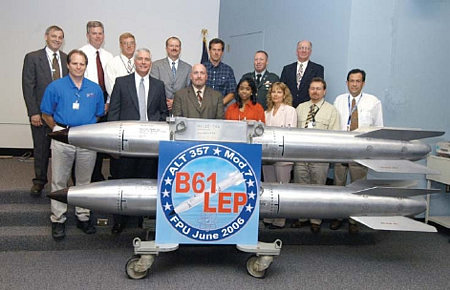 |
| After having spent hundreds of millions of dollars on refurbishing the B61-7, NNSA now plans to scrap the weapon and replace it with the B61-12. |
.
The anticipated cost of the B61-12 program is now greater than the high-end cost estimate for the CMRR-NF, the plutonium pit production factory planned at Los Alamos that the Senate recently decided to mothball for at least five years due to its high cost. Or if that is not impressive enough, the cost of the B61 LEP is comparable to what NNSA plans to spend on sustaining the entire active stockpile for the next decade.
This level of nuclear cost increase and mismanagement is neither justifiable nor sustainable. It shouldn’t be normally, but it certainly isn’t in the current financial crisis. And all of this to sustain a nuclear deployment is Europe that may well end before the B61 LEP is completed and a nuclear capability on the B-2 bomber that already carries another nuclear bomb.
The current B61-12 program should be stopped and reassessed to reduce cost and scope. Congress has already asked the JASONs to examine the scope of the program and provide an assessment of any major concerns. In the meantime, the mission in Europe should temporarily be sustained with a much more basic life-extension program while the administration works to convince NATO to agree to a withdrawal of the remaining U.S. nuclear weapons from Europe. The nuclear capability of the B-2 bomber should be limited to what it already carries.
See also report: Non-Strategic Nuclear Weapons
This publication was made possible by a grant from Carnegie Corporation of New York and Ploughshares Fund. The statements made and views expressed are solely the responsibility of the author.
New Report: US and Russian Non-Strategic Nuclear Weapons
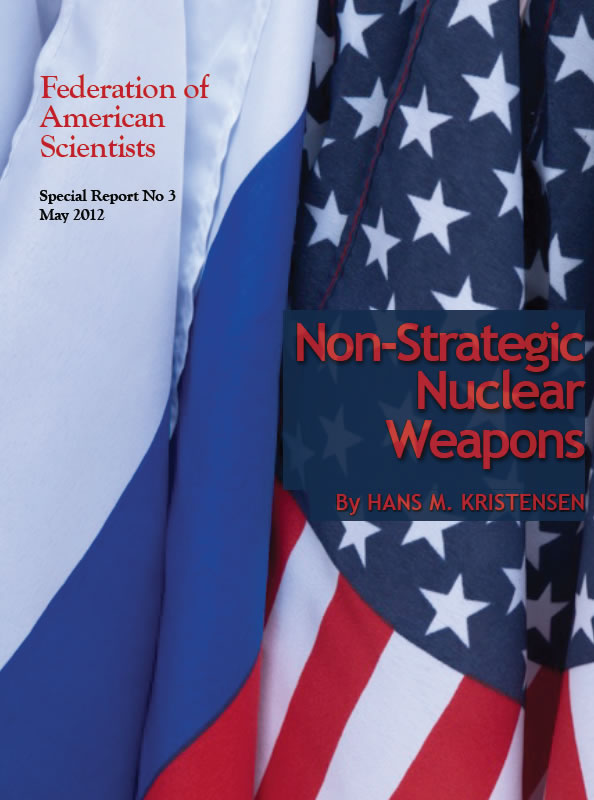 |
| A new report describes U.S. and Russian non-strategic nuclear weapons |
.
By Hans M. Kristensen
A new report estimates that Russia and the United States combined have a total of roughly 2,800 nuclear warheads assigned to their non-strategic nuclear forces. Several thousands more have been retired and are awaiting dismantlement.
The report comes shortly before the NATO Summit in Chicago on 20-21 May, where the alliance is expected to approve the conclusions of a year-long Deterrence and Defense Posture Review that will, among other things, determine the “appropriate mix” of nuclear and non-nuclear forces in Europe. It marks the 20-year anniversary of the Presidential Unilateral Initiatives in the early 1990s that resulted in sweeping reductions of non-strategic nuclear weapons.
Twenty years later, the new report Non-Strategic Nuclear Weapons estimates that U.S. and Russian non-strategic nuclear forces are deployed at nearly 100 bases across Russia, Europe and the United States. The nuclear warheads assigned to these forces are in central storage, except nearly 200 bombs that the U.S. Air Force forward-deploys in almost 90 underground vaults inside aircraft shelters at six bases in five European countries.
The report concludes that excessive and outdated secrecy about non-strategic nuclear weapons inventories, characteristics, locations, missions and dismantlements have created unnecessary and counterproductive uncertainty, suspicion and worst-case assumptions that undermine relations between Russia and NATO.
Russia and the United States and NATO can and should increase transparency of their non-strategic nuclear forces by disclosing overall numbers, storage locations, delivery vehicles, and how much of their total inventories have been retired and are awaiting dismantlement.
The report concludes that unilateral reductions have been, by far, the most effective means to reducing the number and role of non-strategic nuclear weapons. Yet now the two sides appear to be holding on to the remaining weapons to have something to bargain with in a future treaty to reduce non-strategic nuclear weapons.
NATO has decided that any further reductions in U.S. nuclear weapons in Europe must take into account the larger Russian arsenal, and Russia has announced that it will not discuss reductions in its non-strategic nuclear forces unless the U.S. withdraws its non-strategic nuclear bombs from Europe. Combined, these positions appear to obstruct reductions rather facilitate reductions. Russian reductions should be a goal, not a precondition, for further NATO reductions.
Download the full report here: /_docs/Non_Strategic_Nuclear_Weapons.pdf
Slides from briefing at U.S. Senate are here: /programs/ssp/nukes/publications1/Brief2012_TacNukes.pdf
See also our Nuclear Notebooks on the total nuclear arsenals of Russia and the United States.
This publication was made possible by a grant from Carnegie Corporation of New York and Ploughshares Fund. The statements made and views expressed are solely the responsibility of the author.
Non-Strategic Nuclear Weapons
On May 20-21, 28 NATO member countries will convene in Chicago to approve the conclusions of a year-long Deterrence and Defense Posture Review (DDPR). Among other issues, the review will determine the number and role of the U.S. non-strategic nuclear weapons deployed in Europe and how NATO might work to reduce its nuclear posture as well as Russia’s inventory of such weapons in the future.
Lack of transparency fuels mistrust and worst-case assumptions and the concerns some eastern NATO countries have about Russia have been used to prevent a withdrawal of the remaining U.S. nuclear weapons from Europe. The DDPR is expected to endorse the current deployment in Europe.
A new FAS report (PDF) concludes that non-strategic nuclear weapons are neither the reason nor the solution for Europe’s security issues today but that lack of political leadership has allowed bureaucrats to give these weapons a legitimacy they don’t possess and shouldn’t have.
New Article: French Nuclear Modernization
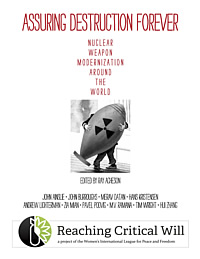
A new report describes worldwide nuclear weapons modernization efforts
By Hans M. Kristensen
The organization Reaching Critical Will has published a collection of articles about the nuclear weapons modernization programs that are underway in the various nuclear weapons states around the world.
My modest contribution is the chapter on France (pages 27-33).
The report – Assuring Destruction Forever – illustrates that although the Cold War nuclear arms race has ended, a global effort to modernize and improve nuclear weapons is in full swing. For some regions (India-Pakistan and India-China) this effort has elements of an arms race, but for most countries it is about extending and improving a nuclear weapons capability indefinitely.
This should remind us why it is increasingly meaningless to assess nuclear arms control progress in numerical terms by comparing the sizes of today’s arsenals with those of the Cold War. Progress increasingly must be measured in constraint: yes, by reducing arsenals further, but perhaps more importantly by curtailing deployments, operations, missions, life-extensions, modernizations and improvements.
Otherwise, the dynamic efforts to extend and modernize the remaining nuclear arsenals may end up working against the nuclear arms control process. Because life-extension and modernization efforts are accompanied by declarations by the nuclear weapon states and alliances about the continued importance of nuclear weapons to national and international security, there is a risk that they will combine to reaffirm and prolong the nuclear weapons era instead of delegitimizing and shortening it.
This publication was made possible by a grant from Carnegie Corporation of New York and Ploughshares Fund. The statements made and views expressed are solely the responsibility of the author.
New Nuclear Notebook: Russian Nuclear Forces 2012
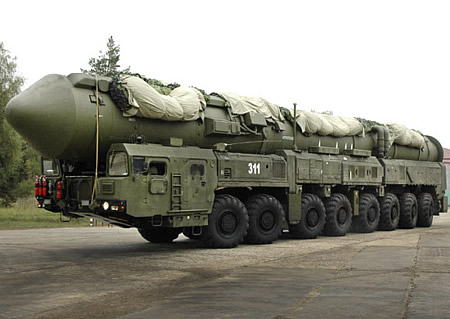 |
| More than two-thirds of Russia’s current ICBM force will be retired over the next 10 years, a reduction that will only partly be offset by deployment of new road-mobile RS-24 Yars (SS-27 Mod 2) ICBMs such as this one near Teykovo northeast of Moscow. |
.
By Hans M. Kristensen
Russia is planning to retire more than two-thirds of its current arsenal of nuclear land-based intercontinental ballistic missiles by the early 2020a. That includes some of the most iconic examples of the Soviet threat against the United States: SS-18 Satan, SS-19 Stiletto, and the world’s first road-mobile ICBM, the SS-25.
The plan coincides with the implementation of the New START treaty but significantly exceeds the reductions required by the treaty.
During the same period, Russia plans to deploy significant numbers of new missiles, but the production will not be sufficient to offset the retirement of old missiles. As a result, the size of Russia’s ICBM force is likely to decline over the next decade – with or without a new nuclear arms control treaty.
This and much more is described in our latest Nuclear Notebook published in the Bulletin of the Atomic Scientists.
This publication was made possible by a grant from Carnegie Corporation of New York and Ploughshares Fund. The statements made and views expressed are solely the responsibility of the author.
Chinese Mobile ICBMs Seen in Central China
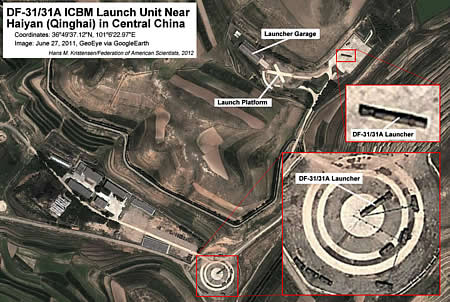 |
| Road-mobile DF-31/31A ICBM launchers deploying to Central China are visible on new commercial satellite images. Click on image for larger version. |
.
By Hans M. Kristensen
Recent satellite images show that China is setting up launch units for its newest road-mobile Intercontinental Ballistic Missile (ICBM) in central China. Several launchers of the new DF-31/31A appeared at two sites in the eastern part of the Qinghai province in June 2011. This is part of China’s slow modernization of its small (compared with Russia and the United States) nuclear arsenal.
An image taken on June 27, 2011 (see above), shows two DF-31/31A launchers on the launch pads of a small launch unit near Haiyan (36°49’37.12″N, 101° 6’22.97″E). One is positioned in a circular pad with support vehicles surrounding it. The circular pad was added to the facility sometime between 2005 and 2010. The other launcher is on a pad to the north, located next to an x-shaped launch pad and a missile garage. The layout of the Haiyan launch site is similar, yet not identical, to the DF-31 launch unit of the 813 Brigade at Nanyang.
Another image taken on June 6, 2011 (see below), shows six DF-31/31A launchers lined up on the parade ground at the 809 Brigade base in Datong about 50 kilometers (32 miles) to the east (36°56’57.67″N, 101°40’2.63″E). The brigade has been thought to be equipped with the DF-21 medium-range missile, but might be under conversion to the longer range DF-31/31A. It is unclear if the launchers are permanently based in the area or temporarily deployed from the 812 Brigade some 500 kilometers (290 miles) to the southeast.
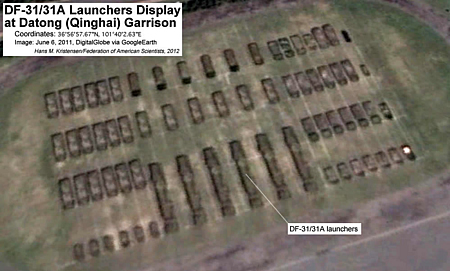 |
| Six mobile DF-31/31A launchers seen on display at a launch brigade in Datong, Qinghai, in central China in June 2011. Click image for larger version. |
.
With an estimated range of 7,200-plus kilometers (4,470 miles), the DF-31 cannot target the continental United States from Central China. But the modification known as DF-31A can with its estimated range of 11,200-plus kilometers (6,960 miles), reach most of the continental United States from Central China. The DF-31/31A missiles can target all of Russia and India from Central China.
Slow Deployment
Deployment of the DF-31 has been slow since it first entered service in 2006. Less than 10 missiles had been deployed with as many launchers by 2010, and not many more were added in 2011.
The DF-31A began deployment in 2007 with about a dozen missiles on as many launchers by 2010. Also counting 20 silo-based DF-5As, the U.S. intelligence community estimates that China currently has “fewer than 50” missiles that can target the continental United States, suggesting that less that 25 DF-31As are currently deployed. (The number is a little more uncertain now after the Pentagon in 2011 started supporting Chinese nuclear secrecy by no longer providing a breakdown of Chinese missile forces in its annual report on Chinese military power).
As older missiles with shorter range are retired and replaced by the DF-31/31A over the next decade, a greater portion of the Chinese missile force will be able to target the continental United States, perhaps twice as many by 2025. But even then, the Chinese force will be small compared with that of Russia and the United States.
Also visit: IMINT & Analysis and Project 2049
Analysis made possible by generous grants from the Carnegie Corporation of New York and the Ploughshares Fund.
This publication was made possible by a grant from Carnegie Corporation of New York and Ploughshares Fund. The statements made and views expressed are solely the responsibility of the author.
Ensuring the Security of Radioactive Sources: National and Global Responsibilities
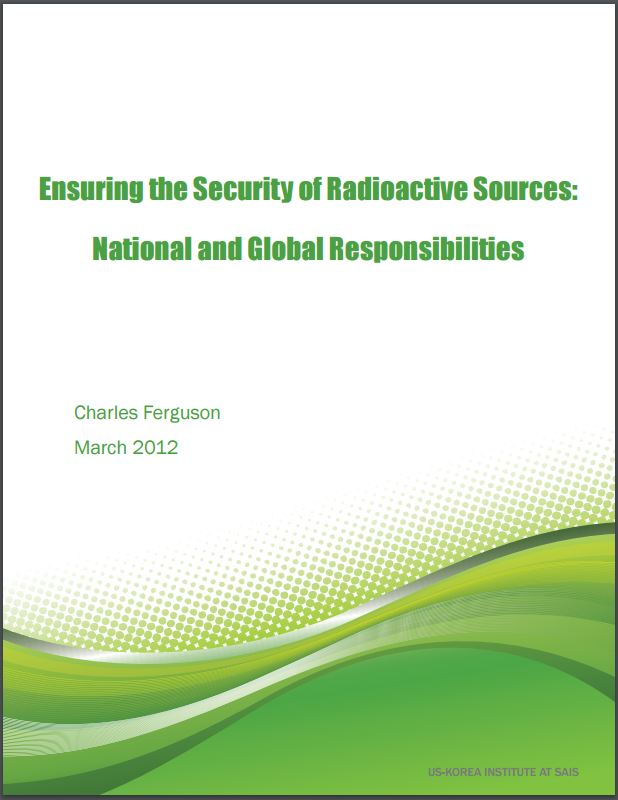
For most of human existence, people were unaware of the powerful nuclear forces deep inside atoms, although they were exposed to natural background radiation derived from these forces. Not until the end of the 19th century did the first “nuclear scientists,” notably Henri Becquerel and Marie and Pierre Curie, discover energetic rays emanating from certain types of atoms due to these forces. Because of its relative natural abundance and its powerful radiation, radium became a workhorse radioactive substance for the first half of the 20th century.
In this report, FAS President Charles Ferguson examines the national and international efforts to control and secure radioactive materials. He provides background on the basic principles of the science of ionizing radiation and radioactive materials; a risk assessment of the safety and security of these materials; a discussion of various pathways for malicious use of commercial radioactive sources; and an analysis of the many efforts underway to reduce the risk of radiological terrorism with recommendations for the inclusion of this issue at the 2012 Seoul Nuclear Security Summit (“Seoul Summit”) and beyond.
A full PDF version of the report can be found here.
